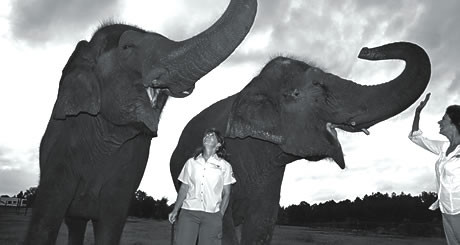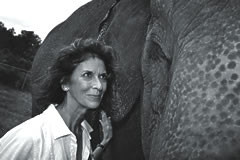SHARE:
Gray Matters - Elephant Breeding
Out in the central Florida hinterlands, the Ringling Bros. circus operates the most successful Asian elephant breeding operation on the continent.
Potency
 Trudy Williams and Janice Aria spend some time with two of the 30 elephants at the 200-acre Center for Elephant Conservation near Polk City. The center is home to the largest herd of Asian elephants in the hemisphere. [Photo: Jeffrey Camp] |
Aside from its stated mission, the center also addresses business problems for the circus. The commitment to conservation may blunt, in the public’s mind, concerns raised in court, outside arenas and on YouTube by groups opposed to Ringling’s inclusion of elephants in its circus.
Ringling also needs a supply of elephants for its shows. Under the 1975 Convention on International Trade in Endangered Species, it’s become all but impossible to import elephants into the United States. The last import was in 1999 to the Oregon Zoo, and that case involved the special circumstance of a 4-year-old orphan elephant blinded in one eye by a gun blast while foraging in a palm oil plantation.
So as Ringling’s performing elephants age, the circus has to turn to replacements born in captivity, which brings us back to the potency of Osgood’s semen. While tigers, for example, reproduce well in captivity, elephants don’t. Some zoos have tried artificial insemination with little success. Gathering elephant sperm from a male and inserting it in a female poses challenges given the scale of the anatomy. And because no one has figured out how to freeze elephant sperm while retaining its viability, as is done in cattle, elephant sperm has to be rushed to a breeding-age female and deposited quickly. Keele says there have been just two births from artificial insemination at U.S. zoos.
That leaves old-fashioned coupling, but only a few zoos have active breeding programs for Asian elephants. Bull elephants usually need to be kept in areas apart from females and from each other. They require lots of space, are tough to handle and are hard on facilities, explains Michael Fouraker, executive director of the Fort Worth Zoo, to which Ringling has loaned a bull elephant for breeding. Fouraker is envious of the Ringling center’s birth rate and speculates that exercise and diet might be the reason. “Honestly, they’re a model for zoos. We’re looking to them for answers,” he says.
 Janice Aria likes to say she ran away from college to join the circus. She joined Ringling’s clown college in 1972 and later worked at the now-defunct Circus World attraction near Haines City. There, 30 years ago, she met Charlie, a captive-born male, who grew up to be a father of 11. “I’m like a grandmother — ‘Oh my! Grandkids!’” the 57-year-old says. [Photo: Jeffrey Camp] |
The center, meanwhile, looks to a bull elephant named Charlie for answers. To facilitate successful impregnation, the center checks female elephants’ progesterone levels weekly at an Ocala lab to get the timing of the female’s four-month cycle. Charlie, however, is nearly as accurate as the lab. “If they’re close to cycling or are cycling, he won’t let them out of his sight,” Williams says, stopping at his barn and flinging Charlie a treat, which Charlie snatches up with his trunk. “We can shift him and the female together, but he’s not going to let you separate him. He keeps them usually for three days and then says, ‘OK, I’m done.’ He’s almost more reliable than the science is, which is helping improve the science.”
Baby elephants are born 22 months after conception, usually weighing 250 to 300 pounds. Even when elephants successfully breed, the infant mortality rate is 35% to 40%, Keele says. Ringling beats the standard with a 10% mortality rate. “Ringling has a great record,” Keele says. “Ringling’s animals are in pretty good shape.”
As the elephants mature, Aria, Williams and staff watch to see which animals have a future as performers. A covered area with music and a barrel toy — the only visible reminders of the circus at the center aside from an old circus rail car that serves as an office — helps determine which young elephants will perform in the arena. As early as age 3, some elephants go off to one of Ringling’s show units to see how they take to the road. Males, once out of the “cute” years, are too unmanageable for the show and go back to the center permanently — a multimillion-dollar lifetime expense, Aria notes.
“Only a third of the elephants that we have, even the young ones that are born, actually end up being performers,” she says. “They’re like people. They don’t all take to it.”
Of Ringling’s 53 elephants, only 17 are in the circus’s two performing units. The center houses most of the others; six are at a retirement facility in Williston in Levy County. Williams says a new barn is planned for the center so those six can be with the others.























